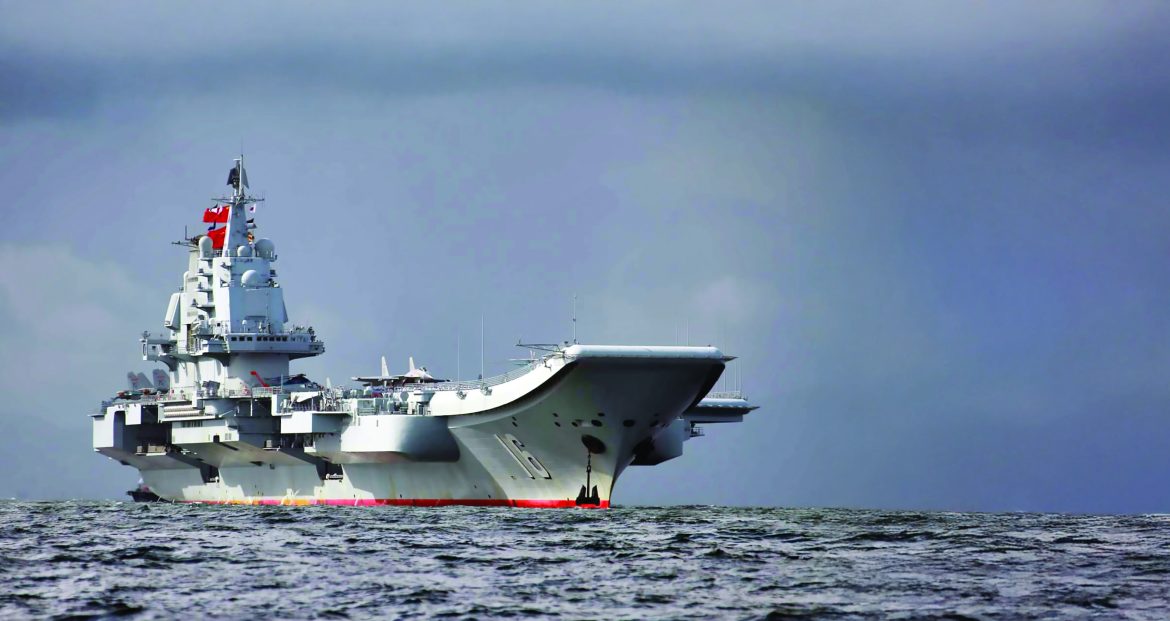Maritime security threats have risen in recent years, with some of the most prominent cases occurring in the South China Sea. These developments have raised pressing questions about how best to respond to such challenges, particularly as great-power competition intensifies—primarily between China, the United States, and regional adversaries in Southeast Asia.

The term “grey zone” is often used to describe contested areas between the exclusive economic zones (EEZs) of different nations. These regions present significant challenges for law enforcement and international coordination, as they often fall outside clearly defined legal jurisdictions.
Grey zone operations typically involve coercive actions designed to secure strategic advantages without triggering full-scale military conflict. These operations often operate below the threshold of war, avoiding direct military confrontation while still achieving geopolitical objectives. By carefully navigating legal and diplomatic ambiguities, those employing grey zone strategies can avoid direct retaliation or international sanctions.
Grey zone operations can be deployed by both stronger and weaker powers. In some cases, a weaker force may use them to challenge a dominant power, leveraging asymmetric tactics to disrupt maritime security. Conversely, stronger powers may deliberately provoke weaker states into a military response—framing them as the aggressor and pushing them into an unwinnable conflict.
China, for instance, has been accused of employing maritime militias to assert control over contested waters in Southeast Asia.
Moreover, grey zone operations frequently exploit legal loopholes to gain an operational advantage. A key example is the uncertainty surrounding how coastal states should respond to an unauthorised warship that fails to comply with the principle of “innocent passage.” The lack of clear legal guidance on whether force can be used in such situations creates an opportunity for strategic manoeuvring. While some grey zone activities adhere to international law, others intentionally violate it, further complicating enforcement efforts.
Although grey zone operations and hybrid warfare share commonalities, they are distinct concepts. Hybrid warfare typically involves a blend of conventional and unconventional military tactics, as seen in Russia’s 2014 annexation of Crimea, where military force played a central role. In contrast, grey zone tactics—such as those used by China in the South China Sea—rely primarily on non-military manoeuvres to expand territorial influence while maintaining diplomatic ties with neighbouring states.
Key Differences Between China’s Maritime Strategy and Russia’s Hybrid Warfare
Several factors distinguish China’s grey zone operations from Russia’s hybrid warfare approach:
• Non-Military vs. Military Emphasis – China’s grey zone strategy is largely maritime and appears non-military in nature, whereas hybrid warfare typically involves direct military engagement, often in urban environments.
• Territorial vs. Strategic Control – Unlike hybrid warfare, which often seeks territorial control over land and populations, grey zone operations focus on expanding dominance over maritime areas rather than controlling specific territories.
• Stability vs. Destabilization – China’s maritime expansion seeks to solidify regional influence without destabilising neighbouring states, whereas hybrid warfare is often used to weaken or fragment adversarial nations.
Moreover, China is attempting to impose its own rules and agenda by establishing a dominant security and political position in the regional international sphere.
China’s maritime campaign primarily employs unarmed or lightly armed vessels, a deliberate choice designed to mitigate the risk of lethal force escalation. This strategy provides Beijing with greater control over the intensity of conflicts in disputed waters. Rather than directly intimidating rival nations with naval warships, China often leverages these assets as signals to external maritime powers, particularly the United States, to deter intervention. The majority of daily operations within the grey zone unfold without direct military involvement. By contrast, hybrid warfare integrates lethal military force alongside various forms of non-lethal coercion.

Information Operations
Information operations play a critical role in hybrid maritime warfare, aiming to spread disinformation, disrupt internal stability, and weaken adversaries from within. However, China’s approach to information campaigns in the grey zone differs. Rather than overt manipulation, Beijing seeks to portray itself as adhering to international law—at least from its perspective—while asserting legitimacy over contested maritime activities. In the South China Sea, China sends clear messages of dominance, reinforcing the futility of resistance. These efforts serve to secure economic resources in disputed areas, limit adversaries’ ability to exploit these resources, protect mainland China from potential threats, and prepare the strategic landscape for any future conflict.
Defining Grey Zone Operations
Grey zone operations encompass hostile campaigns conducted by state and non-state actors that combine military and non-military tools while remaining below the threshold of armed conflict. These operations aim to frustrate, destabilise, or weaken adversaries while exploiting vulnerabilities within targeted states. One primary objective is to reinforce sovereignty claims over islands—inhabited or uninhabited—or specific maritime zones. In some cases, these tactics apply additional pressure on opposing states rather than working toward a direct resolution of territorial disputes. Additionally, grey zone strategies can function as a precursor to full-scale military operations aimed at achieving broader maritime dominance.
Forms of Hybrid Maritime Warfare
China, among other nations, has been accused of employing hybrid warfare tactics in the maritime domain. These strategies include:
1. Utilising ‘Civilian’ Forces: China strategically employs its coast guard and maritime militias, often composed of fishermen, alongside conventional naval forces. This approach enables Beijing to assert control over disputed territories gradually, as seen in the Scarborough Shoal standoff in 2012 and the Ayungin Shoal confrontation in the Spratly Islands in 2013. These so-called civilian actors, appearing to operate independently of the Chinese government, engage in harassing foreign vessels and restricting their access to territorial waters.
They justify these actions as spontaneous efforts to uphold maritime law, yet their activities align with Beijing’s broader sovereignty claims over the South China Sea. Despite a 2016 international tribunal ruling invalidating China’s extensive territorial claims, Beijing has largely ignored the verdict, continuing to assert dominance over the region.
2. Artificial Island Construction: China has employed an anti-access/area-denial (A2/AD) strategy in the South China Sea by constructing artificial islands. Through large-scale land reclamation, China has built dual-use civilian and military infrastructure on these artificial formations, significantly enhancing its ability to control disputed waters. These projects serve both defensive and offensive functions—dissuading rival military forces from accessing contested areas while expanding Beijing’s strategic footprint.
For example, the deployment of anti-ship and surface-to-air missile systems on Fiery Cross, Subi, and Mischief Reefs has granted China effective control over the Spratly Islands. Since 2018, these installations have provided Beijing with the capability to challenge all aerial and naval movements within the archipelago, solidifying its hold over the region.
3. Naval Military Exercises: Between 2022 and 2024, the People’s Liberation Army (PLA) conducted three large-scale military exercises around Taiwan, demonstrating Beijing’s diverse operational capabilities should it decide to invade the island. Taiwan, which Beijing views as an integral part of China, has occasionally signalled its desire for independence, further escalating tensions. By normalising military drills in Taiwanese waters, China seeks to erode Taipei’s ability to gauge whether such manoeuvres signal a genuine invasion.
These exercises serve multiple strategic purposes: enhancing PLA combat readiness, gathering intelligence, and exerting psychological pressure on Taiwan’s leadership. The latest exercise, ‘Joint Sword,’ was explicitly framed as a punitive response to Taiwan’s political actions following the inauguration of President Lai. For the first time, the PLA coordinated military drills with law enforcement operations around Taiwan and its outlying islands. The Chinese Coast Guard also breached restricted waters near Dongyin and Wuqiu islands, engaging in maritime law enforcement exercises, including water cannon drills and boarding inspections.
4. Blocking Other Nations’ Navies
Chinese measures aimed at deterring other nations’ navies from operating in the disputed regions include ramming and sinking Filipino fishing vessels, seizing fishing equipment, and deploying water cannons against Philippine ships. Additionally, China has engaged in land reclamation efforts, militarising maritime features within the Philippines’ exclusive economic zone to solidify its claims.
One notable incident occurred on 16 June 2024, when a Filipino sailor aboard the BRP Bagacay sustained serious injuries while attempting to deliver humanitarian supplies to the BRP Sierra Madre, a grounded vessel serving as an outpost on Second Thomas Shoal. Chinese vessels aggressively obstructed the mission by employing high-pressure water cannons, deliberate ramming, towing manoeuvres, and blockades. This marked the third such incident in which Filipino personnel were harmed while delivering supplies to Sierra Madre. Despite overwhelming evidence of Chinese aggression, Beijing blamed the collision on the Filipino ship and defended its actions as “lawful control measures.”
China has further escalated tensions by implementing new regulations in June 2024, allowing its coast guard to detain foreign nationals found “illegally” entering disputed waters for up to sixty days without trial, reinforcing its unilateral claims over the South China Sea.
Countermeasures by Regional and Global Powers
Faced with China’s increasingly assertive tactics, neighbouring states and allied nations, including the United States, have begun formulating responses aimed at countering these grey zone operations. Several strategies have emerged:
• Adopting Similar Tactics: One approach involves mirroring China’s methods, such as establishing maritime militias and conducting deliberate collision manoeuvres. In December 2024, Vice Admiral Jose Ma. Ambrosio Ezpeleta, the newly appointed head of the Philippine Navy, hinted at adopting grey zone strategies similar to Beijing’s in the South China Sea. Even before this, the Philippines had begun emulating Chinese tactics. In June 2024, a Philippine supply vessel came dangerously close to a Chinese ship, resulting in a minor collision near Second Thomas Shoal. While Manila argued its right to operate within its EEZ, Beijing accused the Philippine vessel of reckless navigation and ignoring multiple warnings. A similar confrontation in August 2024 saw another collision between Chinese and Philippine ships, with both sides exchanging blame.
• Deploying Non-Lethal Weapons: To counter Chinese maritime intimidation without triggering open conflict, some nations are exploring the use of non-lethal deterrents. These include long-range acoustic devices paired with translation systems for clear verbal warnings, high-powered dazzler lasers to obscure vision, and electromagnetic pulse systems designed to disable electronic controls and ship engines. Another potential tool is the Active Denial System, which uses directed energy to induce temporary pain without causing injury, compelling adversaries to withdraw from contested areas. U.S. think tanks advocate for such methods as a means of resisting China’s grey zone tactics while minimizing the risk of escalation. However, the effectiveness of these measures in deterring Beijing without provoking further aggression remains uncertain.
• Strengthening Maritime Alliances: In response to growing Chinese assertiveness, regional powers have intensified military and diplomatic cooperation with global allies. The Philippines has bolstered its strategic partnership with the United States, particularly regarding the defence of Second Thomas Shoal. Washington has been urged to provide regular naval escorts for Philippine resupply missions to Sierra Madre, facilitate the construction of permanent structures on the reef, and enhance intelligence, surveillance, and reconnaissance (ISR) capabilities in the disputed waters. These measures aim to reinforce Manila’s position and deter further Chinese encroachments.
• Deploying Light Naval Forces: Another proposal under consideration in the U.S. involves establishing a fleet of lightly armed patrol vessels specifically designed for contested maritime zones. Unlike destroyers, these ships would be low-cost, non-lethal assets serving as symbolic deterrents. The rationale is that any Chinese attempt to engage an American patrol vessel—regardless of its firepower—would carry the same strategic consequences as attacking a warship, thereby complicating Beijing’s calculations. A related suggestion involves procuring additional frigates, allowing the U.S. Navy to allocate its more advanced destroyers to high-priority deterrence missions.
The Broader Implications of Grey Zone Warfare
China’s grey zone operations reflect a broader strategy to achieve geopolitical objectives without resorting to outright military conflict. By deploying civilian fishing fleets to obstruct rival naval movements and exert control over disputed waters, Beijing avoids crossing conventional red lines that would trigger a direct military response. While these tactics may seem manageable in isolation, any attempt to counter them with lethal force could provide China with a pretext for large-scale military intervention.
For regional actors like the Philippines, the challenge lies in finding effective countermeasures that do not escalate tensions into full-blown conflict. While mirroring China’s tactics could serve as a deterrent, it also risks spiralling into an uncontrolled escalation.
As a result, U.S. involvement in the region is expected to grow, with Washington seeking to balance deterrence with diplomatic efforts to prevent conflict.
By: Dr. Shadi Abdelwahab (Associate Professor, National Defence College)













